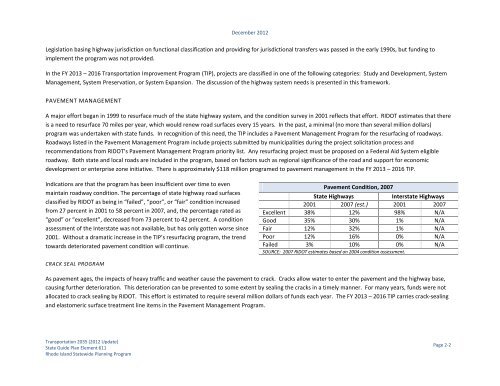Transportation 2035 - State of Rhode Island: Division of Planning
Transportation 2035 - State of Rhode Island: Division of Planning
Transportation 2035 - State of Rhode Island: Division of Planning
You also want an ePaper? Increase the reach of your titles
YUMPU automatically turns print PDFs into web optimized ePapers that Google loves.
December 2012Legislation basing highway jurisdiction on functional classification and providing for jurisdictional transfers was passed in the early 1990s, but funding toimplement the program was not provided.In the FY 2013 – 2016 <strong>Transportation</strong> Improvement Program (TIP), projects are classified in one <strong>of</strong> the following categories: Study and Development, SystemManagement, System Preservation, or System Expansion. The discussion <strong>of</strong> the highway system needs is presented in this framework.PAVEMENT MANAGEMENTA major effort began in 1999 to resurface much <strong>of</strong> the state highway system, and the condition survey in 2001 reflects that effort. RIDOT estimates that thereis a need to resurface 70 miles per year, which would renew road surfaces every 15 years. In the past, a minimal (no more than several million dollars)program was undertaken with state funds. In recognition <strong>of</strong> this need, the TIP includes a Pavement Management Program for the resurfacing <strong>of</strong> roadways.Roadways listed in the Pavement Management Program include projects submitted by municipalities during the project solicitation process andrecommendations from RIDOT’s Pavement Management Program priority list. Any resurfacing project must be proposed on a Federal Aid System eligibleroadway. Both state and local roads are included in the program, based on factors such as regional significance <strong>of</strong> the road and support for economicdevelopment or enterprise zone initiative. There is approximately $118 million programed to pavement management in the FY 2013 – 2016 TIP.Indications are that the program has been insufficient over time to evenmaintain roadway condition. The percentage <strong>of</strong> state highway road surfacesclassified by RIDOT as being in “failed”, “poor”, or “fair” condition increasedfrom 27 percent in 2001 to 58 percent in 2007, and, the percentage rated as“good” or “excellent”, decreased from 73 percent to 42 percent. A conditionassessment <strong>of</strong> the Interstate was not available, but has only gotten worse since2001. Without a dramatic increase in the TIP’s resurfacing program, the trendtowards deteriorated pavement condition will continue.Pavement Condition, 2007<strong>State</strong> HighwaysInterstate Highways2001 2007 (est.) 2001 2007Excellent 38% 12% 98% N/AGood 35% 30% 1% N/AFair 12% 32% 1% N/APoor 12% 16% 0% N/AFailed 3% 10% 0% N/ASOURCE: 2007 RIDOT estimates based on 2004 condition assessment.CRACK SEAL PROGRAMAs pavement ages, the impacts <strong>of</strong> heavy traffic and weather cause the pavement to crack. Cracks allow water to enter the pavement and the highway base,causing further deterioration. This deterioration can be prevented to some extent by sealing the cracks in a timely manner. For many years, funds were notallocated to crack sealing by RIDOT. This effort is estimated to require several million dollars <strong>of</strong> funds each year. The FY 2013 – 2016 TIP carries crack-sealingand elastomeric surface treatment line items in the Pavement Management Program.<strong>Transportation</strong> <strong>2035</strong> (2012 Update)<strong>State</strong> Guide Plan Element 611<strong>Rhode</strong> <strong>Island</strong> <strong>State</strong>wide <strong>Planning</strong> ProgramPage 2-2
















